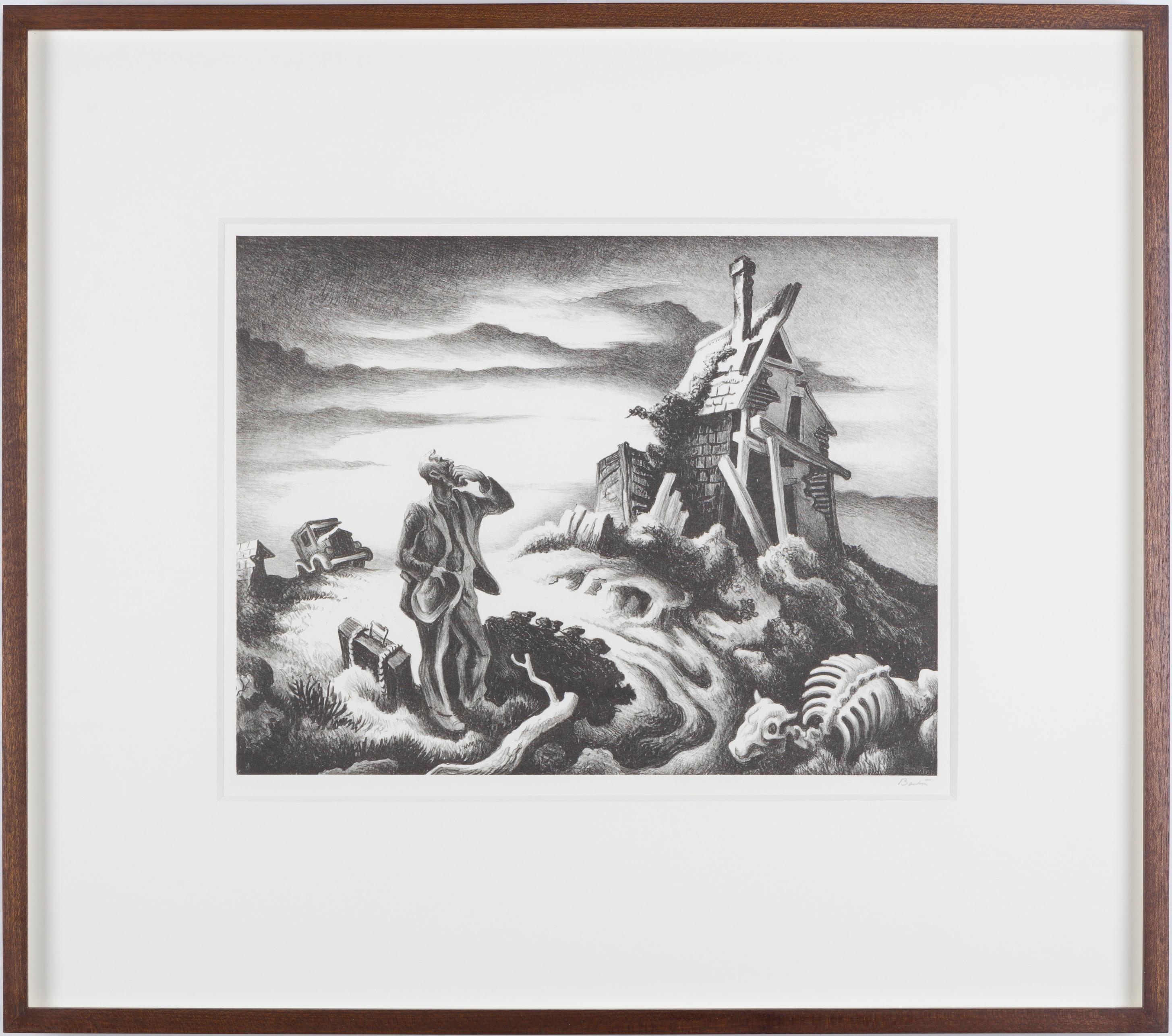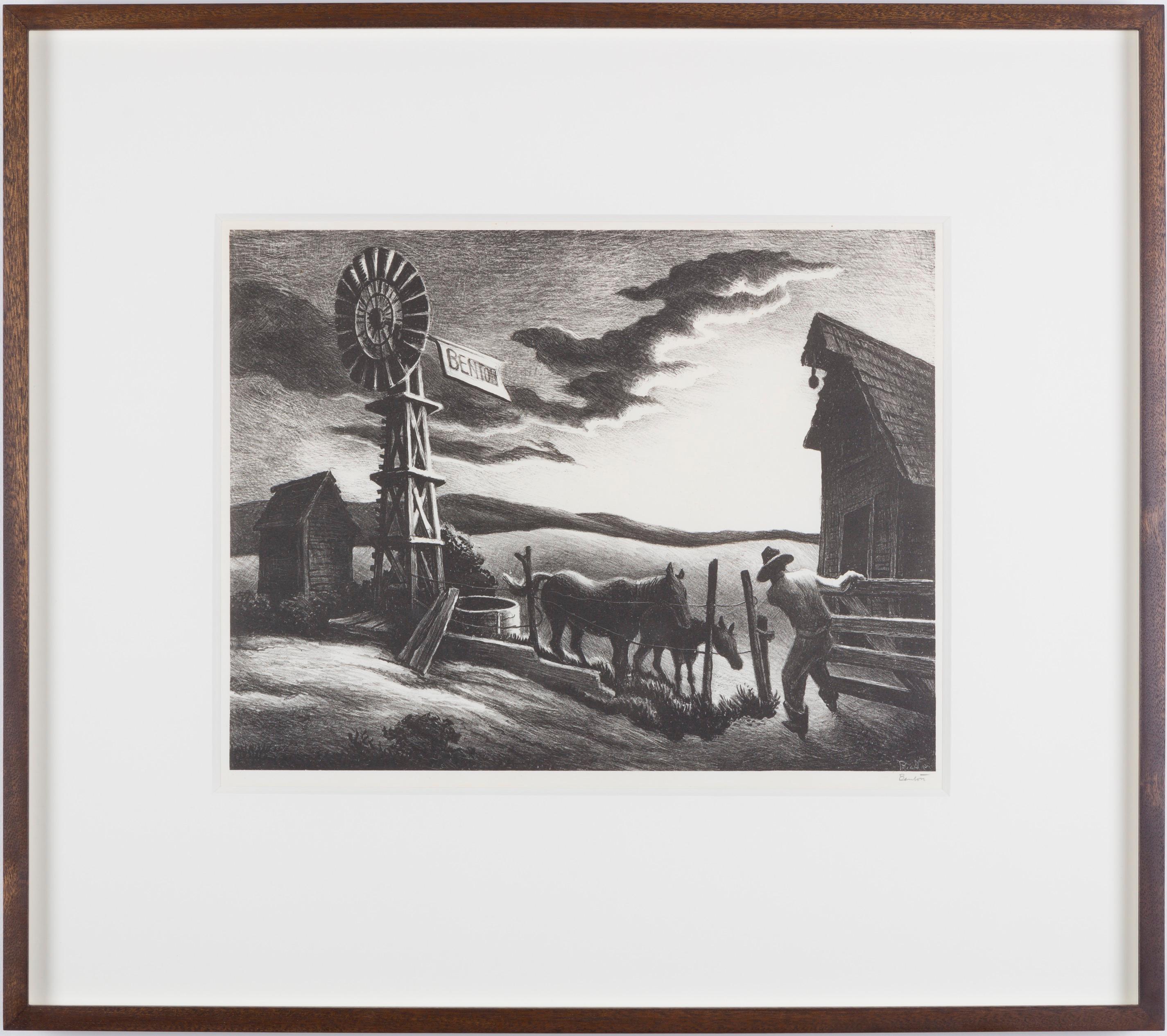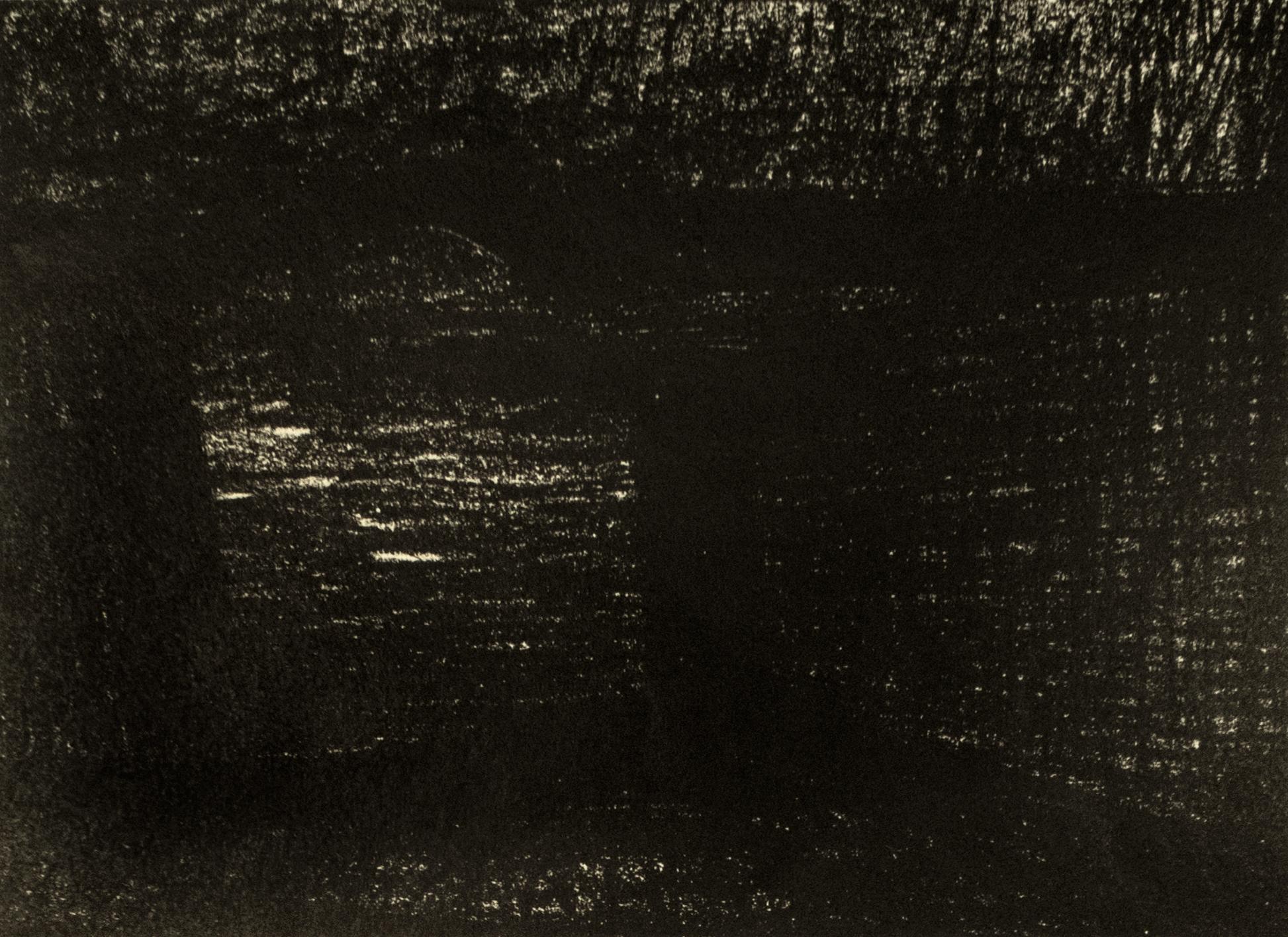Items Similar to La butte de Montmartre et le Sacre-Couer (Sacre Coeur from a Distance)
Want more images or videos?
Request additional images or videos from the seller
1 of 7
Robert DelaunayLa butte de Montmartre et le Sacre-Couer (Sacre Coeur from a Distance)1926
1926
About the Item
La butte de Montmartre et le Sacre-Couer (Sacre Coeur from a Distance)
Lithograph, 1926
From Joseph Delteil's "Allo, Paris," published by Quatre Chemins, Paris, 1926
Rare signed proof on chine (see photo)
Altlier blindstamp l.l., Lugt 4982, recto (see photo)
Condition: Minor imperfections
Sheet size: 11 1/4 x 8 5/8 inches
Regarding the book "Allo, Paris"
Allo! Paris!
1926
The complete set of 20 lithographs, with text, title page and justification, on Arches paper, with full margins, bound (as issued) to accompany the text by Joesph Delteil,
28.5 x 23 cm (11 1/4 x 9 in.)
stamp-numbered '220' on the justification, from the edition of 300 (there were also 40 hors commerce impressions in Roman Numerals, 15 on Hollande van Gelder paper and 25 on Arches), published by Editions des Quatre Chemins, Paris.
- Creator:Robert Delaunay (1885-1941, French)
- Creation Year:1926
- Dimensions:Height: 11.25 in (28.58 cm)Width: 8.63 in (21.93 cm)
- Medium:
- Movement & Style:
- Period:
- Condition:
- Gallery Location:Fairlawn, OH
- Reference Number:
About the Seller
5.0
Recognized Seller
These prestigious sellers are industry leaders and represent the highest echelon for item quality and design.
Platinum Seller
These expertly vetted sellers are 1stDibs' most experienced sellers and are rated highest by our customers.
Established in 1978
1stDibs seller since 2013
711 sales on 1stDibs
Typical response time: 1 hour
Associations
International Fine Print Dealers Association
- ShippingRetrieving quote...Ships From: Fairlawn, OH
- Return PolicyA return for this item may be initiated within 10 days of delivery.
More From This SellerView All
- New York NightBy Adolf DehnLocated in Fairlawn, OHNew York Night\Lithograph, 1930 Edition: 30 Printer: Meister Schulz, Berlin Printed on heavy wove paper without watermark This lithograph was created in...Category
1930s American Modern Landscape Prints
MaterialsLithograph
- Brooklyn WaterfrontBy Adolf Arthur DehnLocated in Fairlawn, OHBrooklyn Waterfront Lithograph, 1931 Signed, titled, and dated in pencil by the artist Edition: Undetermined (very small), plus artist's proofs Printed by Meister Schulz, Berlin Provenance: Estate of the artist Virginia Dehn, the artist's widow Dehn Quests Bibliography: Lumsdaine and O'Sullivan 152 Illustrated: Adams, The Sensuous Life of Adolf Dehn, Fig. 9.14, page 213 (This impression) Adolf Dehn, American Watercolorist and Printmaker, 1895-1968 Adolf Dehn was an artist who achieved extraordinary artistic heights, but in a very particular artistic sphere—not so much in oil painting as in watercolor and lithography. Long recognized as a master by serious print collectors, he is gradually gaining recognition as a notable and influential figure in the overall history of American art. In the 19th century, with the invention of the rotary press, which made possible enormous print runs, and the development of the popular, mass-market magazines, newspaper and magazine illustration developed into an artistic realm of its own, often surprisingly divorced from the world of museums and art exhibitions, and today remains surprisingly overlooked by most art historians. Dehn in many regards was an outgrowth of this world, although in an unusual way, since as a young man he produced most of his illustrative work not for popular magazines, such as The Saturday Evening Post, but rather for radical journals, such as The Masses or The Liberator, or artistic “little magazines” such as The Dial. This background established the foundation of his outlook, and led later to his unique and distinctive contribution to American graphic art. If there’s a distinctive quality to his work, it was his skill in introducing unusual tonal and textural effects into his work, particularly in printmaking but also in watercolor. Jackson Pollock seems to have been one of many notable artists who were influenced by his techniques. Early Years, 1895-1922 For an artist largely remembered for scenes of Vienna and Paris, Adolf Dehn’s background was a surprising one. Born in Waterville, Minnesota, on November 22, 1895, Dehn was the descendent of farmers who had emigrated from Germany and homesteaded in the region, initially in a one-room log cabin with a dirt floor. Adolf’s father, Arthur Clark Dehn, was a hunter and trapper who took pride that he had no boss but himself, and who had little use for art. Indeed, during Adolf’s boyhood the walls of his bedroom and the space under his bed were filled with the pelts of mink, muskrats and skunks that his father had killed, skinned and stretched on drying boards. It was Adolf’s mother, Emilie Haas Dehn, a faithful member of the German Lutheran Evangelical Church, who encouraged his interest in art, which became apparent early in childhood. Both parents were ardent socialists, and supporters of Eugene Debs. In many ways Dehn’s later artistic achievement was clearly a reaction against the grinding rural poverty of his childhood. After graduating from high school in 1914 at the age of 19—an age not unusual in farming communities at the time, where school attendance was often irregular—Dehn attended the Minneapolis School of Art from 1914 to 1917, whose character followed strongly reflected that of its director, Munich-trained Robert Kohler, an artistic conservative but a social radical. There Dehn joined a group of students who went on to nationally significant careers, including Wanda Gag (later author of best-selling children’s books); John Flanagan (a sculptor notable for his use of direct carving) Harry Gottlieb (a notable social realist and member of the Woodstock Art Colony), Elizabeth Olds (a printmaker and administrator for the WPA), Arnold Blanch (landscape, still-life and figure painter, and member of the Woodstock group), Lucille Lunquist, later Lucille Blanch (also a gifted painter and founder of the Woodstock art colony), and Johan Egilrud (who stayed in Minneapolis and became a journalist and poet). Adolf became particularly close to Wanda Gag (1893-1946), with whom he established an intense but platonic relationship. Two years older than he, Gag was the daughter of a Bohemian artist and decorator, Anton Gag, who had died in 1908. After her husband died, Wanda’s mother, Lizzi Gag, became a helpless invalid, so Wanda was entrusted with the task of raising and financially supporting her six younger siblings. This endowed her with toughness and an independent streak, but nonetheless, when she met Dehn, Wanda was Victorian and conventional in her artistic taste and social values. Dehn was more socially radical, and introduced her to radical ideas about politics and free love, as well as to socialist publications such as The Masses and The Appeal to Reason. Never very interested in oil painting, in Minneapolis Dehn focused on caricature and illustration--often of a humorous or politically radical character. In 1917 both Dehn and Wanda won scholarships to attend the Art Students League, and consequently, in the fall of that year both moved to New York. Dehn’s art education, however, ended in the summer of 1918, shortly after the United States entered World War I, when he was drafted to serve in the U. S. Army. Unwilling to fight, he applied for status as a conscientious objector, but was first imprisoned, then segregated in semi-imprisonment with other Pacifists, until the war ended. The abuse he suffered at this time may well explain his later withdrawal from taking political stands or making art of an overtly political nature. After his release from the army, Dehn returned to New York where he fell under the spell of the radical cartoonist Boardman Robinson and produced his first lithographs. He also finally consummated his sexual relationship with Wanda Gag. The Years in Europe: 1922-1929 In September of 1921, however, he abruptly departed for Europe, arriving in Paris and then moving on to Vienna. There in the winter of 1922 he fell in love with a Russian dancer, Mura Zipperovitch, ending his seven-year relationship with Wanda Gag. He and Mura were married in 1926. It was also in Vienna that he produced his first notable artistic work. Influenced by European artists such as Jules Pascin and Georg Grosz, Dehn began producing drawings of people in cafes, streets, and parks, which while mostly executed in his studio, were based on spontaneous life studies and have an expressive, sometimes almost childishly wandering quality of line. The mixture of sophistication and naiveté in these drawings was new to American audiences, as was the raciness of their subject matter, which often featured pleasure-seekers, prostitutes or scenes of sexual dalliance, presented with a strong element of caricature. Some of these drawings contain an element of social criticism, reminiscent of that found in the work of George Grosz, although Dehn’s work tended to focus on humorous commentary rather than savagely attacking his subjects or making a partisan political statement. Many Americans, including some who had originally been supporters of Dehn such as Boardman Robinson, were shocked by these European drawings, although George Grocz (who became a friend of the artist in this period) admired them, and recognized that Dehn could also bring a new vision to America subject matter. As he told Dehn: “You will do things in America which haven’t been done, which need to be done, which only you can do—as far at least as I know America.” A key factor in Dehn’s artistic evolution at this time was his association with Scofield Thayer, the publisher of the most notable modernist art and poetry magazine...Category
1920s American Modern Landscape Prints
MaterialsLithograph
- Niagara FallsBy Adolf Arthur DehnLocated in Fairlawn, OHNiagara Falls Lithograph, 1931 Signed lower right (see photo) Titled/edition lower left. (see photo) Edition of 25 Provenance: the Estate of the Artist Condition: Excellent Image si...Category
1930s American Modern Landscape Prints
MaterialsLithograph
- Poplar Tree BBy Shiko MunakataLocated in Fairlawn, OHPoplar Tree B Lithograph, c. 1959 Signed and numbered in pencil by the artist (see photo) Artist's red stamp lower left margin (see photo) Edition: 50 (30/50) Printed by Arthur Flory...Category
1950s Modern Landscape Prints
MaterialsLithograph
- Trout Fishing on the Gunnison (Colorado)By Adolf DehnLocated in Fairlawn, OHTrout Fishing on the Gunnison (Colorado) Lithograph, 1941 Signed and dated '42 in pencil lower right Annotated lower left: "40 Prints-The Gunnison River, Colorado-For Anne & Jack" Ed...Category
1940s American Modern Landscape Prints
MaterialsLithograph
- St. George Hotel SearchlightBy Adolf DehnLocated in Fairlawn, OHSt. George Hotel Searchlight Lithograph, 1930 Signed in pencil lower right (see photo) Titled lower left (see photo) Edition: 30 Printed by Meister Schulz, Berlin The image depicts t...Category
1930s American Modern Landscape Prints
MaterialsLithograph
You May Also Like
- Prodigal SonBy Thomas Hart BentonLocated in London, GBA fine impression with full margins published by Associated American Artists with their information label present - pictured in Art and Popular Religion in Evangelical America, 1815-...Category
1930s American Modern Landscape Prints
MaterialsLithograph
- Nebraska EveningBy Thomas Hart BentonLocated in London, GBA fine impression with good margins published by Associated American Artists.Category
1940s American Modern Landscape Prints
MaterialsLithograph
- Thin-lipped Armourer I: black drawing based on Auden poetry, Yorkshire landscapeBy Henry MooreLocated in New York, NYThis darkly-shaded portrait of two figures is one of a series of 18 lithographs drawn by the artist for the Auden Poems/Moore Lithographs 1974 book and portfolio. This work is from a...Category
Late 20th Century Modern Abstract Prints
MaterialsLithograph
- Blue Rolling Waves off Sidney, Seascape Diptych Cyanotype, Australian Coast SurfBy Kind of CyanLocated in Barcelona, ESThis is an exclusive handprinted limited edition cyanotype. "Rolling Waves off Sidney" is a gorgeous original cyanotype diptych showing energetic waves embracing the Australian coas...Category
2010s Modern Landscape Drawings and Watercolors
MaterialsPhotogram, Photographic Film, Monotype, Lithograph, Dye Transfer, Color,...
- Sketches of Auden: black drawing based on Auden poetry and Yorkshire landscapeBy Henry MooreLocated in New York, NYThis black and white portrait drawing is one of a series of 18 lithographs drawn by the artist for the Auden Poems/Moore Lithographs 1974 book and portfolio. This work is from an edition of 25 printed on vellum aside from the portfolio (edition of 75) and the book. Signed by the artist and numbered 8/25 lower right in pencil. This print features a pair of sketches...Category
Late 20th Century Modern Abstract Prints
MaterialsLithograph
- Bridge: abstract black drawing based on Auden poetry and Yorkshire landscapeBy Henry MooreLocated in New York, NYOne of a series of 18 lithographs drawn by the artist for the Auden Poems/Moore Lithographs 1974 book and portfolio. This work is from an edition of 25 printed on vellum aside from t...Category
Late 20th Century Modern Landscape Prints
MaterialsLithograph
Recently Viewed
View AllMore Ways To Browse
Delaunay Lithograph
Roman Arch
Roman Arch Print
Sacre Coeur
Sacre Coeur Paris
Montmartre Sacre Coeur
Van Gelder
Le Sacre Coeur
Sacre Coeur De Montmartre
Engravings Of Trees
Masterworks Fine Art
Sailboat Print
Trees Woodcut Print
Antique Etchings Landscape
Oxford Etching
Liberty Vintage Fabric
Liberty Fabric Vintage
Liberty Vintage Fabrics





